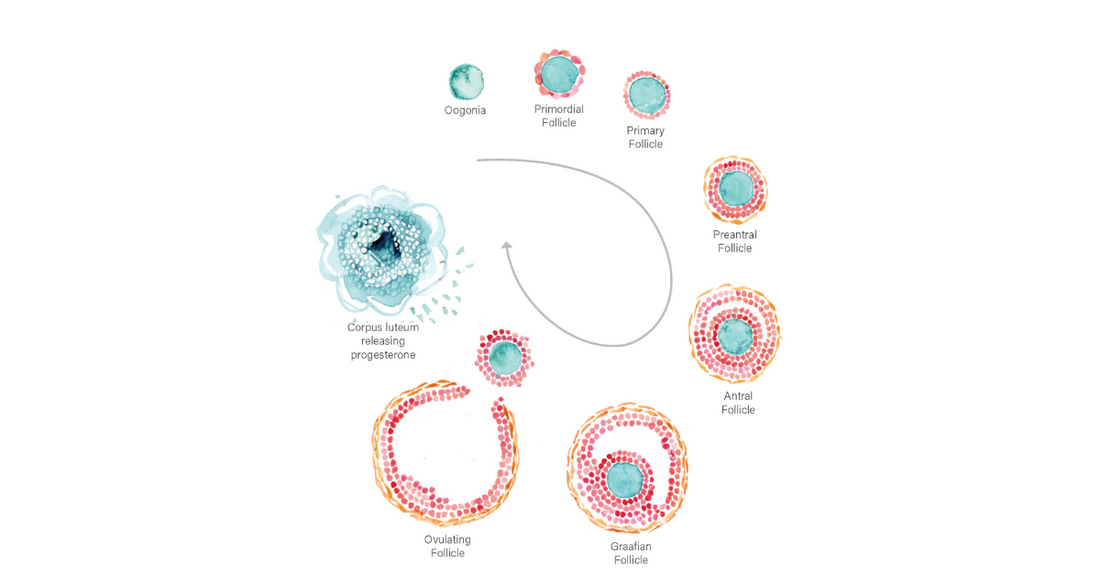Early pregnancy loss is heartbreaking. If you have experienced loss and are waiting for your rainbow baby, know you are not alone. When I experienced my miscarriages no one was talking about their experience even though early loss occurs in 15-25% of pregnancies.
With the presence of endometriosis miscarriage rates may be up to 80% higher [1], and individuals with PCOS can experience 10 times greater rates of loss [2]. Let’s encourage conversation around pregnancy loss and know that we are here to support you on your journey!
While there are many factors that can contribute to early pregnancy loss one of these is low levels of progesterone. Progesterone is essential for maintaining a pregnancy. Low progesterone is an issue we commonly see in clinic at The IVF Project so in this blog we are going to discuss what may be contributing to low progesterone and steps to help support progesterone production.
Where Does Progesterone Come From?
While small amounts of progesterone are made in the adrenal cortex and brain, most progesterone comes from inside the ovary. In our ovary our eggs develop inside follicles. Once the follicle ruptures to release an egg, the left over follicle becomes the corpus luteum which gets to work producing progesterone.
If an egg is fertilised and implants, the pregnancy hormone hCG will signal the corpus luteum to keep producing progesterone.
If there is no fertilisation the corpus luteum will break down about 10 days after the egg was released at ovulation. This is why progesterone levels will rise after ovulation and then decrease prior to the first day of menstrual bleeding.
Progesterone and Egg Health
Increasing progesterone levels in the second half of your menstrual cycle are a sign of healthy ovulation (this is a vital sign!). If our hormones are in balance our follicles develop in a better environment with less inflammation. A healthy follicle means that the egg maturing inside is also growing in a healthy environment. Ovulation taking place is a good indicator that you are producing healthy eggs, and this provides the best chance of the corpus luteum to produce more progesterone. If you want to find out if you are ovulating read here.
Low progesterone levels following ovulation occur if the corpus luteum is not functioning well. If the follicle has been growing in an environment of greater inflammation, egg health is impacted, ovulation may be impaired and the corpus luteum will not produce as much progesterone.
Causes of Low Progesterone
Hypothalamic Amenorrhea: If your period is missing, there may be a number of contributors. One common cause relates to polycystic ovary syndrome (PCOS), but another cause may be related to an imbalance of activity, stress, and energy intake. This is called hypothalamic amenorrhea.
Hypothalamic amenorrhea reduces the normal secretion of hormones from the brain, ultimately reducing oestradiol and progesterone levels. This leads to irregular menstrual periods, no menstrual periods, or a short luteal phase. A missing period not only reduces the chance of natural conception but also indicates disruption of the follicle that impacts egg quality.
Endometriosis: Endometriosis is an oestrogen driven inflammatory condition. Chronic inflammation disrupts the maturation of follicles and impacts egg quality. It is even possible that the environment in the ovary is so disrupted that ovulation does not take place [3].
Without a healthy follicle and corpus luteum, progesterone levels are reduced.
Polycystic Ovary Syndrome (PCOS): Following ovulation in individuals with PCOS, progesterone does not rise as it usually would. One study reported a progesterone level of 4.9 ng/ml during the luteal phase in females with PCOS compared to a control group where progesterone rose to 21.6 ng/ml [4].
Insulin resistance, high androgens and inflammation all impact the development of follicles. If the follicle isn’t maturing as it should, the corpus luteum won’t produce enough progesterone, and levels will be lower.
Three Ways to Increase Progesterone Naturally
A progesterone rise after ovulation is a good sign of healthy eggs, and is necessary for healthy pregnancy progression. Here are some natural ways to ensure a healthy rise in post-ovulation progesterone level:
Exercise
The right balance of exercise dampens inflammation, creating a healthy environment for our follicles. Exercise can even restore ovulation so if your period has been missing and you are not exercising regularly, add some walking and weights to your weekly routine. Ovulating regularly is a sign of a healthy follicle, healthy eggs and functioning corpus luteum that will produce enough progesterone.
Mindfulness
If we are experiencing stress or high functioning anxiety our sympathetic nervous system is often in overdrive. There is evidence that this can have a negative impact on follicle development. An increase in activation of our sympathetic nervous system disrupts our gut microbiota, increases intestinal permeability, and increases inflammation.
Activities that calm an overactive nervous system include singing, dancing, mindfulness and increasing the diversity of your gut microbiome. Find an activity that helps you stay in the moment and quiet your mind for a healthy corpus luteum.
Nurture Your Gut Microbiome
A healthy gut microbiome dampens inflammation to support progesterone production, and in turn progesterone reinforces the intestinal barrier to nurture a fertile gut. Prebiotic components like α-Linolenic Acid (par of our Microbiome Essentials) increase the abundance of beneficial gut microbes and restores balance to sex hormones including progesterone.
Our prebiotic components also enhance insulin sensitivity, oestrogen balance, reduce inflammation and lower endotoxin to support healthy ovulation, egg quality and progesterone production.
When Do I Test Progesterone Levels?
Signs of ovulation are a good predictor that your progesterone levels will rise in the luteal phase. If you do want to determine your progesterone levels you can have a blood test to checked 6 to 8 days after ovulation in the later half of your cycle (if you have a 28 day cycle measure progesterone on day 21).
Regular ovulation is a great vital sign so keep track of your cycle. Here’s to creating a fertile gut for optimal progesterone production and pregnancy success. Wishing you your rainbow baby!
DOWNLOAD our FREE guide on fighting inflammation for pregnancy success here:
Learn how to nurture your gut microbiome for pregnancy success with Create a Fertile Gut

References
- 1. Minebois, H., et al., [Endometriosis and miscarriage: Systematic review]. Gynecol Obstet Fertil Senol, 2017. 45(7-8): p. 393-399.
- 2. Pan, M.L., L.R. Chen, and K.H. Chen, The Risk of Subsequent Miscarriage in Pregnant Women with Prior Polycystic Ovarian Syndrome: A Nationwide Population-Based Study. Int J Environ Res Public Health, 2021. 18(16).
- 3. Brosens, I.A., P.R. Koninckx, and P.A. Corveleyn, A study of plasma progesterone, oestradiol-17beta, prolactin and LH levels, and of the luteal phase appearance of the ovaries in patients with endometriosis and infertility. Br J Obstet Gynaecol, 1978. 85(4): p. 246-50.
- 4. Meenakumari, K.J., et al., Effects of metformin treatment on luteal phase progesterone concentration in polycystic ovary syndrome. Braz J Med Biol Res, 2004. 37(11): p. 1637-44.






